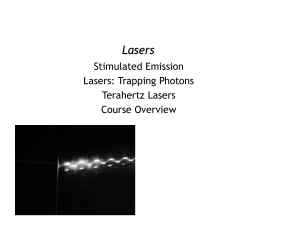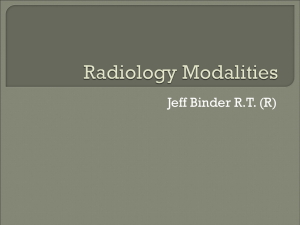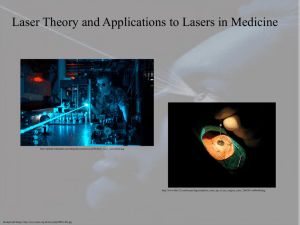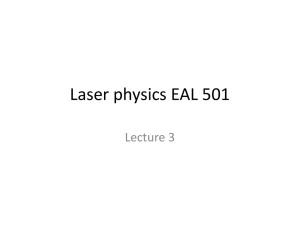Lecture14,ch10 with examples
advertisement
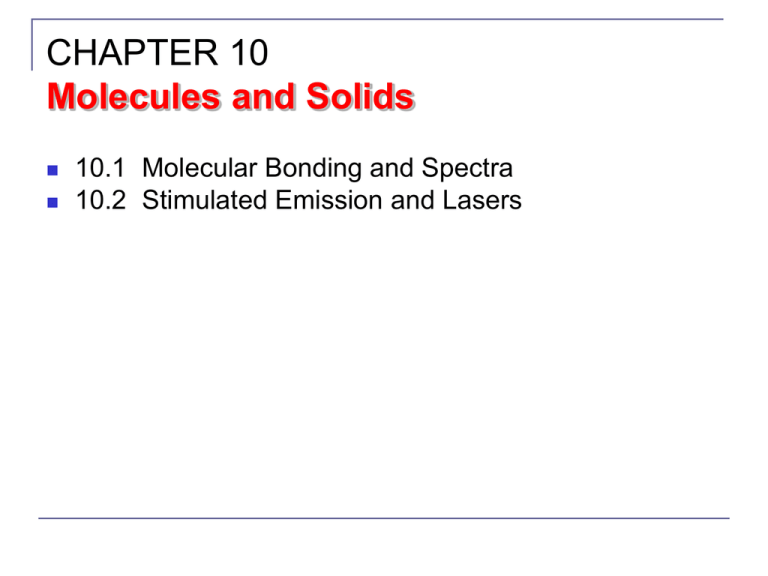
CHAPTER 10 Molecules and Solids 10.1 Molecular Bonding and Spectra 10.2 Stimulated Emission and Lasers 10.1: Molecular Bonding and Spectra The Coulomb force is the only one to bind atoms. The combination of attractive and repulsive forces creates a stable molecular structure. Force is related to potential energy F = −dV / dr, where r is the distance separation. it is useful to look at molecular binding using potential energy V Negative slope (dV / dr < 0) with repulsive force Positive slope (dV / dr > 0) with attractive force Molecular Bonding and Spectra An approximation of the potential of one atom in the vicinity of another atom is where A and B are positive constants. Because of the complicated shielding effects of the various electron shells, n and m are not equal to 1. Eq. 10.1 provides a stable equilibrium for total energy E < 0. The shape of the curve depends on the parameters A, B, n, and m. Also n > m. Molecular Bonding and Spectra Vibrations are excited thermally, so the exact level of E depends on temperature. Once a pair of atoms is joined, then: One would have to supply energy to raise the total energy of the system to zero in order to separate the molecule into two neutral atoms. The corresponding value of r at the minimum value is an equilibrium separation. The amount of energy to separate the two atoms completely is the binding energy which is roughly equal to the depth of the potential well. Molecular Bonds Ionic bonds: The simplest bonding mechanisms. Ex: Sodium (1s22s22p63s1) readily gives up its 3s electron to become Na+, while chlorine (1s22s22p63s23p5) readily gains an electron to become Cl−. That forms the NaCl molecule. Covalent bonds: The atoms are not as easily ionized. Ex: Diatomic molecules (H2, N2, O2) formed by the combination of two identical atoms tend to be covalent. These are referred to as homopolar molecules. Larger molecules are formed with covalent bonds. Molecular Bonds Van der Waals bond: Weak bond found mostly in liquids and solids at low temperature Ex: In graphite, the van der Waals bond holds together adjacent sheets of carbon atoms. As a result, one layer of atoms slides over the next layer with little friction. The graphite in a pencil slides easily over paper. Hydrogen bond: Holds many organic molecules together Metallic bond: Free valence electrons may be shared by a number of atoms. Rotational States Molecular spectroscopy: We can learn about molecules by studying how molecules absorb, emit, and scatter electromagnetic radiation. From the equipartition theorem, the N2 molecule may be thought of as two N atoms held together with a massless, rigid rod (rigid rotator model). In a purely rotational system, the kinetic energy is expressed in terms of the angular momentum L and rotational inertia I. Rotational States L is quantized. The energy levels are Erot varies only as a function of the quantum number l. Clicker - Questions Vibrational States There is the possibility that a vibrational energy mode will be excited. No thermal excitation of this mode in a diatomic gas at ordinary temperature. It is possible to stimulate vibrations in molecules using electromagnetic radiation. Assume that the two atoms are point masses connected by a massless spring with simple harmonic motion: Vibrational States The energy levels are those of a quantum-mechanical oscillator. The frequency of a two-particle oscillator is Where the reduced mass is μ = m1m2 / (m1 + m2) and the spring constant is κ. If it is a purely ionic bond, we can compute κ by assuming that the force holding the masses together is Coulomb. and Clicker - Questions Compare the fundamental vibrational frequencies of HCl and NaCl and select the true statement a) The fundamental vibrational frequencies are equal b) The fundamental vibrational frequency of HCl is higher c) The fundamental vibrational frequency of HCl is lower d) The fundamental vibrational frequency of HCl is changing with temperature Vibration and Rotation Combined It is possible to excite the rotational and vibrational modes simultaneously. Total energy of simple vibration-rotation system: Vibrational energies are spaced at regular intervals. emission features due to vibrational transitions appear at regular intervals: ½ħω, 3/2ħω, etc. Transition from l + 1 to l: Photon will have an energy Vibration and Rotation Combined An emission-spectrum spacing that varies with l The higher the starting energy level, the greater the photon energy. Vibrational energies are greater than rotational energies. This energy difference results in the band spectrum. Typical section of the emission spectrum of a diatomic molecule. Equally spaced groups of lines correspond to the equal spacings between vibrational levels. The structure within each group is due to transitions between rotational levels. Vibration and Rotation Combined The positions and intensities of the observed bands are ruled by quantum mechanics. Note two features in particular: 1) The relative intensities of the bands are due to different transition probabilities. - The probabilities of transitions from an initial state to final state are not necessarily the same. 2) Some transitions are forbidden by the selection rule that requires Δℓ = ±1. Absorption spectra: Within Δℓ = ±1 rotational state changes, molecules can absorb photons and make transitions to a higher vibrational state when electromagnetic radiation is incident upon a collection of a particular kind of molecule. Vibration and Rotation Combined ΔE increases linearly with l as in Eq. (10.8). A schematic diagram of the absorptive transitions between adjacent vibrational states ( n = 0 to n = 1) in a diatomic molecule. Vibration and Rotation Combined In the absorption spectrum of HCl, the spacing between the peaks can be used to compute the rotational inertia I. The missing peak in the center corresponds to the forbidden Δℓ = 0 transition. The central frequency Vibration and Rotation Combined Fourier transform infrared (FTIR) spectroscopy: Data reduction method for the sole purpose of studying molecular spectra. It is based on the Michelson interferometer. A spectrum can be decomposed into an infinite series of sine and cosine functions. With slow scanning random and instrumental noise can be reduced in order to produce a “clean” spectrum. Typical scanning time is tens of minutes/spectrum Dual frequency comb spectroscopy A novel version of FTR without moving parts and with 10^-3 s/spectrum “seeing the heart beat of molecules” Optical depth (L ) Dual comb spectroscopy in ambient air 8 Hitran simulation 580 m multipass 1.2 ppmv CH4 (1.8 ppmv CH4~ wiki) 0.0012 H2O 6 ~ 4% relative humidity in room temp. 4 2 data acquisition time < 100 ms Optical depth (-ln (I/I 0)) 0 0 2 4 6 MIR Dual comb spetroscopy 8 2900 2950 3000 3050 Wavenumber (cm-1) 3100 3150 Stimulated Emission and Lasers Einstein’s analysis: Consider transitions between two molecular states with energies E1 and E2 (where E1 < E2). Eph is an energy of either emission or absorption. f is a frequency where Eph = hf = E2 − E1. If stimulated emission occurs: The number of molecules in the higher state (N2) The energy density of the incoming radiation (u(f)) the rate at which stimulated transitions from E2 to E1 is B21N2u(f) (where B21 is a proportional constant) The probability that a molecule at E1 will absorb a photon is B12N1u(f) The rate of spontaneous emission will occur is AN2 (where A is a constant) Stimulated Emission and Lasers Once the system has reached equilibrium with the incoming radiation, the total number of downward and upward transitions must be equal. In the thermal equilibrium each of Ni are proportional to their Boltzmann factor . In the classical time limit T → ∞. Then becomes very large. and u(f) The probability of stimulated emission is approximately equal to the probability of absorption. Stimulated Emission and Lasers Solve for u(f), or, use Eq. (10.12), This closely resembles the Planck radiation law, but Planck law is expressed in terms of frequency. Eqs.(10.13) and (10.14) are required: The probability of spontaneous emission (A) is proportional to the probability of stimulated emission (B) in equilibrium. Vibration and Rotation Combined A transition from l to l + 2 Let hf be the Raman-scattered energy of an incoming photon and hf ’ is the energy of the scattered photon. The frequency of the scattered photon can be found in terms of the relevant rotational variables: Raman spectroscopy is used to study the vibrational properties of liquids and solids. 10.2: Stimulated Emission and Lasers Spontaneous emission: A molecule in an excited state will decay to a lower energy state and emit a photon, without any stimulus from the outside. The best we can do is calculate the probability that a spontaneous transition will occur. If a spectral line has a width ΔE, then a lower-bound estimate of the lifetime is Δt = ħ / (2 ΔE). Stimulated Emission and Lasers Stimulated emission: A photon incident upon a molecule in an excited state causes the unstable system to decay to a lower state. The photon emitted tends to have the same phase and direction as the stimulated radiation. If the incoming photon has the same energy as the emitted photon: The result is two photons of the same wavelength and phase traveling in the same direction. Because the incoming photon just triggers emission of the second photon. Stimulated Emission and Lasers Einstein’s analysis: Consider transitions between two molecular states with energies E1 and E2 (where E1 < E2). Eph is an energy of either emission or absorption. f is a frequency where Eph = hf = E2 − E1. If stimulated emission occurs: The number of molecules in the higher state (N2) The energy density of the incoming radiation (u(f)) the rate at which stimulated transitions from E2 to E1 is B21N2u(f) (where B21 is a proportional constant) The probability that a molecule at E1 will absorb a photon is B12N1u(f) The rate of spontaneous emission will occur is AN2 (where A is a constant) Stimulated Emission and Lasers Once the system has reached equilibrium with the incoming radiation, the total number of downward and upward transitions must be equal. In the thermal equilibrium each of Ni are proportional to their Boltzmann factor . In the classical time limit T → ∞. Then becomes very large. and u(f) The probability of stimulated emission is approximately equal to the probability of absorption. Stimulated Emission and Lasers Solve for u(f), or, use Eq. (10.12), This closely resembles the Planck radiation law, but Planck law is expressed in terms of frequency. Eqs.(10.13) and (10.14) are required: The probability of spontaneous emission (A) is proportional to the probability of stimulated emission (B) in equilibrium. Stimulated Emission and Lasers Laser: An acronym for “light amplification by the stimulated emission of radiation” Masers: Microwaves are used instead of visible light. The first working laser by Theodore H. Maiman in 1960 helium-neon laser Clicker - Questions If laser=light amplification by stimulated emission of radiation, then what is ‘maser’ stand for? a) macrowave amplification by stimulated emission of radiation b) microwave amplification by stimulated emission of radiation c) milliwave amplification by stimulated emission of radiation Stimulated Emission and Lasers The body of the laser is a closed tube, filled with about a 9/1 ratio of helium and neon. Photons bouncing back and forth between two mirrors are used to stimulate the transitions in neon. Photons produced by stimulated emission will be coherent, and the photons that escape through the silvered mirror will be a coherent beam. How are atoms put into the excited state? We cannot rely on the photons in the tube; if we did: 1) Any photon produced by stimulated emission would have to be “used up” to excite another atom. 2) There may be nothing to prevent spontaneous emission from atoms in the excited state. The beam would not be coherent. Stimulated Emission and Lasers Use a multilevel atomic system to see those problems. Three-level system 1) 2) 3) Atoms in the ground state are pumped to a higher state by some external energy. The atom decays quickly to E2. The transition from E2 to E1 is forbidden by a Δℓ = ±1 selection rule. E2 is said to be metastable. Population inversion: more atoms are in the metastable than in the ground state Stimulated Emission and Lasers After an atom has been returned to the ground state from E2, we want the external power supply to return it immediately to E3, but it may take some time for this to happen. A photon with energy E2 − E1 can be absorbed. result would be a much weaker beam This is undesirable because the absorbed photon is unavailable for stimulating another transition. Stimulated Emission and Lasers Four-level system 1) Atoms are pumped from the ground state to E4. They decay quickly to the metastable state E3. The stimulated emission takes atoms from E3 to E2. The spontaneous transition from E2 to E1 is not forbidden, so E2 will not exist long enough for a photon to be kicked from E2 to E3. Lasing process can proceed efficiently. 2) 3) 4) Stimulated Emission and Lasers The red helium-neon laser uses transitions between energy levels in both helium and neon. The Nobel Prize in Chemistry 1999 was awarded to Ahmed Zewail"for his studies of the transition states of chemical reactions using femtosecond spectroscopy". http://www.lindau-repository.org/nobellabs360/gm_theodorhaensch/index.html My groups scientific applications of lasers Atto and femto second spectroscopy in strong laser fields Precision measurements of the Fundamental Constants Sensing of Greenhouse gases in the atmosphere Sniffing methane from natural seeps and petroleum reservoirs Looking for exoplanets (Qatar b,Khalid Alsubai) Breath analysis for monitoring stages of diabetes . 10.1) Consider again the rotational energy states of the N2 molecule as described in Example 10.1. Find the energy involved in a transition (a) from the l=2 to l=1 state, and (b) from the l=10 to l=9 state. 10.2) (a) Use the data in table 10.1 to find the approximation spacing between vibrational energy levels in CO. (b) What temperature would be needed to excite this vibration thermally? 10.7) If the energy of a vibrational transition from n=0 state to the n=1 state in CO could be absorbed in a rotational transition that begins in the ground state ( l=0 ), what would be the value of l for the final state? Explain why such a rotational transition is impossible. 10.18) (a) How many photons are emitted each second from a 5.0mW helium-neon laser ( λ=632.8 nm )? (b) If the laser contains 0.02 mole of neon gas, what fraction of the neon atoms in the tube participate in the lasing process during each second of operation? (c) Comment on the relatively low numerical result in (b). 10.19) A laser emits 5.50x1018 photons per second, using a transition from an excited state with energy 1.15 eV to a ground state with energy 0 eV. (a) What is the laser’s power output? (b) What is the wavelength? Homework 9 Chap.10 #1,2,7,18,19

